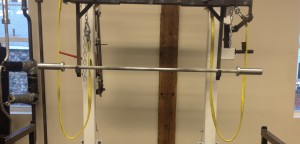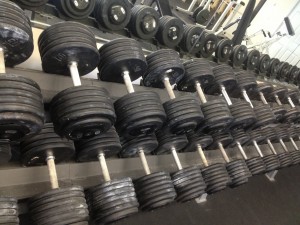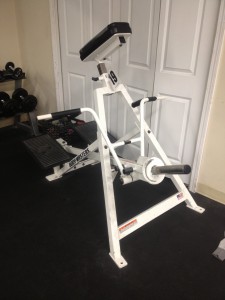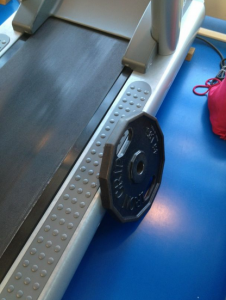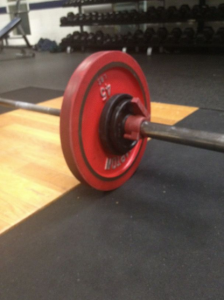Barbells and Weights:
Barbells:
Barbells can range anywhere from 4’ (1.2 m) to 8 feet (2.4 m) long, and can vary in diameter from .98”-2” (25 mm-51 mm).
Olympic bar:
This is the standard training barbell (olympic men’s barbell). This bar is 7.2 ft (2.2m) long and will weigh ~ 45 lbs (20 kg).

Some gyms have a “women’s bar” which is 33lbs (15 kg) and is only 6.9 ft (2.1 m) long. There are also smaller “training bars” that can weigh anywhere from 10-30lbs.
Fixed weight bars :
These are shorter bars (3′-4′) with the weights already attached. They’re usually located all together near the dumbbells and are used primarily for assistance exercises.
Dumbbells:
Most gyms will have dumbbells, even if they don’t have free weight barbells. While there are a few different styles, for most purposes, a dumbbell is a dumbbell. I’ve seen dumbbells anywhere from 1lb to 200lbs.
EZ-Curl bars are the most common “speciality bar,” which are shorter and bent a “w” shape. Sadly, I’ve seen gyms that do not have your normal training barbell have EZ-Curl bars. Unfortunately, the only thing these bars are really good for is curls and other accessory movements.
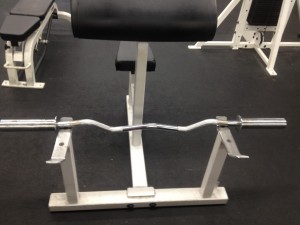
“Trap Bar” – This bar is in the shape of a diamond, allowing the user to stand in the middle and pick up the bar using a neutral grip. It is primarily used for deadlifts, but definitely not necessary (an olympic bar is standard).
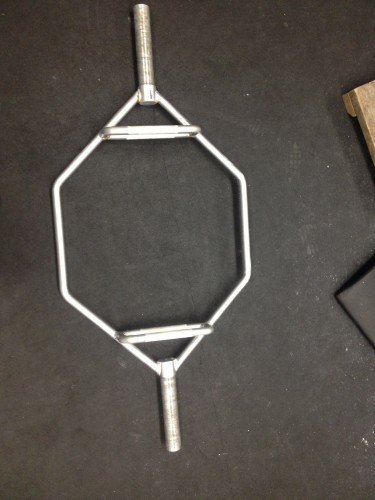
Safety Squat Bar, Cambered Bars, Apollon’s Axle, Strongman Logs (and a ton of other types) – While these are not necessary by any means, they can be a great tool once you’re further along your strength training journey. Also, if a gym has speciality bars, it’s likely they are more of a weightlifting gym (and probably where you want to be.)
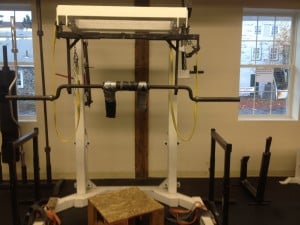
Racks and Machines
There are a ton of different types of racks and every gym (or basement or garage) has a different one! Let’s go over the basic equipment you’ll be using to squat and do your major “push” and “pull” exercises.
Squat Stands – these are two pieces that you stand next to each other that hold up your barbell. These are great for portable workouts, but for inside a gym they have a lot of disadvantages (they don’t hold as much weight, aren’t as sturdy, and lack safety features). Basically – they are better than nothing, but not the best.
Squat Racks – Squat racks come in many shapes and sizes, but most typically they are two vertical uprights connected with a horizontal pole. Some have safeties built in and some do not ). The ones that do not are not much better than the individual squat stands. If you have a choice, a squat rack with adjustable safeties is your best bet.
Power Rack – One step above the squat rack is the power rack. These look like big metal rectangles with holes every 2 inches or so up and down all of the vertical sides. These will have a safety pin going horizontally across each side near the bottom and J-hooks up higher to hold the barbell. One of the great things about your gym having a power rack is that it’s versatile – you can use it to bench press, overhead press, etc. as well.
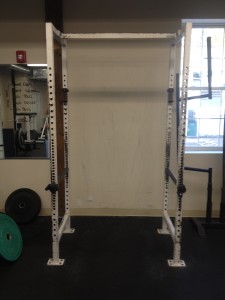
Monolift – the least common and typically only found at more serious powerlifting gyms. With these, after you get the weight on your back, you have a friend pull a lever that moves the stand out of your way so you can squat without stepping out of the rack at all.
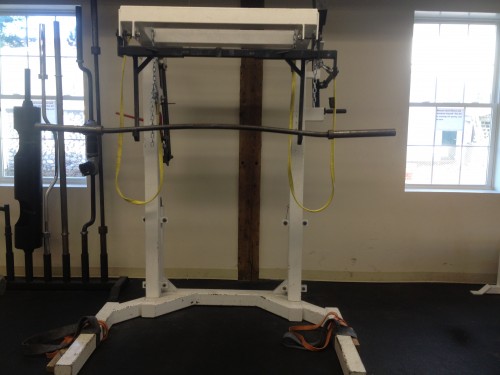
Smith Machine – the smith machine is a type of plate loaded machine that looks a lot like a squat rack, only there are rods that guide the path of the bar. There are two types – NOTE: While staff at the gym may tell you that they are safer to use, we never recommend using them as it forces your body into fixed, unnatural positions and it’s been proven that you get better gains out of using free weights.
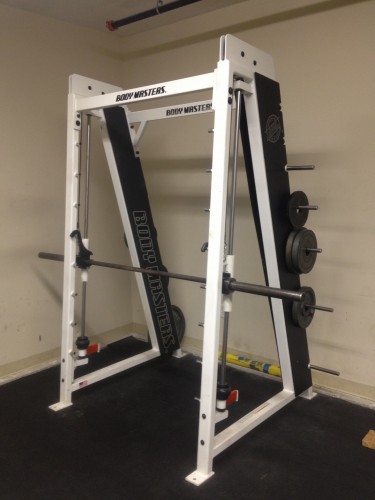
“So how do I tell the difference between a smith machine and a squat rack?” Is the bar attached to something without being able to be removed off the machine? It’s a smith machine. That simple
Weight Machines – There are two main types of these, plate loaded and pin loaded. The pin loaded (or ‘stack machines’) have stacks of rectangular “weights” with a hole in them for you to insert a pin into. The lower down you insert the pin, the more weights are lifted. The advantage of these is that you do not need to load weights on and off between sets. In plate loaded, there are no weights attached to the machine – you must put the weight plates on the machine yourself. Many plate loaded machines offer a higher range of motion than stack loaded machines.
Cable Machines – these come in all sorts of different shapes and sizes, but are always stack loaded machines. With these machines, a handle is attached to the end of a cable which is then pushed or pulled in various directions depending on the specific exercise. These can be great for assistance exercises to your barbell or dumbbell lifts as unlike other weight machines, they still allow free range of movement.
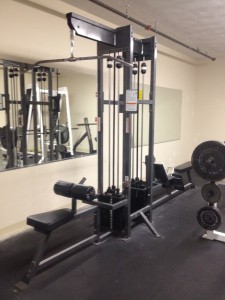
Pull-up Bar – you would be surprised how many gyms do not have a good pullup bar. There are two places to look for one if they do not have a freestanding pullup bar – one is on the top of the cable machine and the other is on the top of the power rack or smith machine. Some offer multiple grip options without offering a straight bar. The two main grip options that are the most useful to find are a straight bar and a neutral grip (where your palms are facing eachother)
Dip Station – sometimes these are freestanding, and sometimes these are attached to the cable machine or power rack. Adjustable handles are nice for those of us who are smaller and using a wider dip station puts our bodies in a bad position.
Assisted Pullup/Dip Station – This is a stack loaded machine – you select a weight, then stand on a platform that offers a specific amount of help on your pullup or dip. These can be useful if you don’t have a pullup or dip yet, though we recommend the use of bands instead.
Bench – There are two main types of benches, standard flat benches and adjustable ones. The adjustable benches let you use them as both a flat bench or at an incline or decline. These are one of the most commonly used pieces of equipment in the weight room so it’s always good if there are at least 3 or 4.

Bench Press Rack – Some gyms (especially smaller gyms and CrossFits) just use squat stands or squat racks for bench press. Most commercial gyms have benches that are specially made for bench press and have the stand attached. These are definitely a preference. However, check to see if the rack is adjustable, especially if you are shorter.
Standard Bench Press:
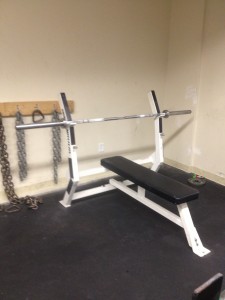
Competition Bench Press:
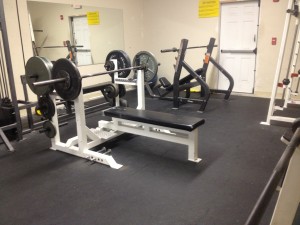
Other pieces of equipment
In addition to all of the big pieces of equipment, there are a ton of little things hanging around in every corner of the gym. Here are a few of the main ones:
Collars/Clips – From spring collars, muscle clamps, to official weightlifting collars, these vary greatly. The purpose of these is to hold the weights onto the bar. Most gyms have a rule that you must have collars on the bar before you lift it (unless the bar is empty). Some of these weigh a few ounces and some weigh up to 5 kg a pair.

Weight Plates – The most common are types of plates are:
Standard metal plates/Rubber Encased Weight Plates – these are the most common in commercial gyms. These shouldn’t be dropped. They come in circle and 12-sided versions – I would look and make sure the plates are circle if you have a choice.
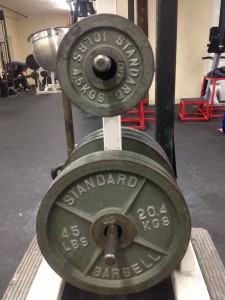
combination metal/rubber plate (so you can drop from short distances)
Bumper Plates are coated in rubber and can be safely dropped from overhead. These are much larger in size due to the rubber coating.

Within the United States, most gyms plates are in pounds and come in 2.5,5,10,25, and 45 lb denominations. Outside the United States or at most weightlifting specialty gyms, the plates will be in kilograms. They are typically found in 1, 1.5, 2, 2.5, 5, 10, 15, 20, and 25kg denominations.
Kettlebells – These are weights that resemble a cannonball with a handle. These are an amazing tool for helping you get stronger (some people train exclusively with kettlebells with great results). Most commercial gyms stay pretty light with these, though if you look you may be able to find a gym with some 53 and 70lb (and maybe higher) kettlebells. If you ever plan on doing any sort of kettlebell work, you’ll grow out of the 8lb ones that most gyms have pretty quick.
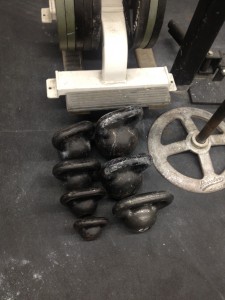
GHR/GHD Machine – this is called the “glute ham raise”, the “glute ham developer”. You can use this for Glute Ham Raises, Back Extensions, or sit ups.
Note: (Most GHR’s are not this big.)
Reverse Hyper – this looks like a table with a pendulum hanging from it. It’s not common, but aside from your basic barbell and squat rack, I think it’s one of the best pieces of equipment in a gym.
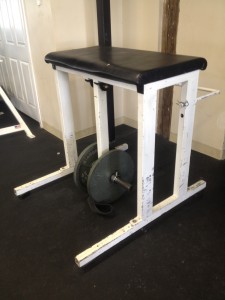
Plyo Boxes – these are boxes that come in multiple sizes that you can jump on and off of. You can also use them for weighted stepups
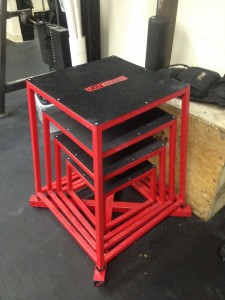
Bands – Bands are basically just gigantic rubber bands, used for mobility work, speed lifts, and for assistance with things such as pullups. These are a great tool to have around.
Use of bands:
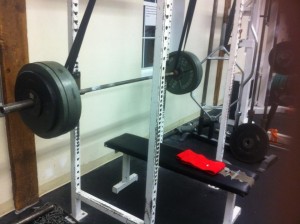
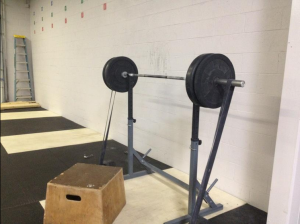
Chains – Chains are a great intermediate/advanced lifter tool.
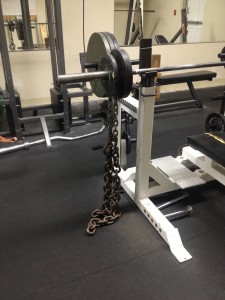
Chalk – a lot of gyms do not allow this, but it’s a huge help when it comes to grip, especially when it gets warm and sweaty in the gym
Gear
The number one question I get asked when someone wants to start lifting is: “What do I wear?” When you look around the gym, you’ll notice that everyone has their own set of gear and their own set of reasons on why they need what they wear. The truth of the matter is: unless you’re injured, when you’re first starting out, you don’t need 90% of the gear you see in the gym (and you really don’t NEED it later on either) .
Clothing – Ignore fashion; wear what’s comfortable. High socks are common on deadliftt day to prevent scraping on your shins, but other than that, it really doesn’t matter. You could do squats in your birthday suit if you want (though I take no responsibility when you get arrested or kicked out of your gym).
Shoes – The number one piece of “gear” I’ll recommend you get is a good pair of shoes to lift in. Now, good lifting shoes do not need to be expensive! The most important quality of a good lifting shoe is being able to drive through your heels – so a flat sole or solid sole is what you’re looking for. Your classic running shoe will not fit the bill here – it’s extremely hard to press through your heels when you’re standing on something as cushy and soft as a running sneaker. (Note: If you can’t get a better shoe, I would rather you squat in running sneakers than not squat at all.) Your classic converse chuck taylor all star will work very well here, are affordable, and is what many top powerlifters still wear.
Gloves – Some people like to use gloves to protect their hands from developing callouses while lifting. However, you still get callouses and your hands can rip from under the gloves. Since they can also mess up your grip and technique, I do not recommend wearing them.
Knee/Wrist Wraps – Not to be confused with straps, the main purpose of wraps are support and stability, though some wear wrist wraps to help with grip as well. Some wraps (mainly used for powerlifting) are so heavy duty that they feel like a cast, and are only worn only for the lift itself. There are also extremely light versions that only offer a tiny bit of support and everything in between. Definitely not necessary unless you have some sort of injury or if you’re trying to squat 600lbs.
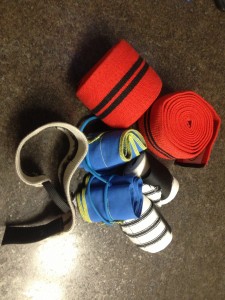
Straps – Straps are wrapped around the bar and are used to help you hold on. These allow you to hold on to weight longer, or train without exhausting your grip. Great tool for intermediate and advanced lifters, but nothing to worry about in the beginning.

Weightlifting Belt – These come in both velcro and leather varieties, and can be very useful for the intermediate and advanced lifter. I did not wear one for the first year of lifting, and even after I started wearing one, it was another few months until I was comfortable that I was using it right.
Velcro:
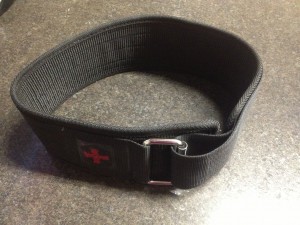
Leather:

If you’re just starting out, don’t worry about having all the right accessories. Get a good pair of shoes and get started!

